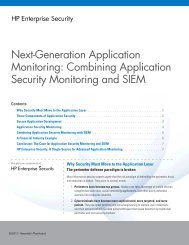Integrated, Real-Time Decision Making: - Bitpipe
Integrated, Real-Time Decision Making: - Bitpipe
Integrated, Real-Time Decision Making: - Bitpipe
You also want an ePaper? Increase the reach of your titles
YUMPU automatically turns print PDFs into web optimized ePapers that Google loves.
TODAY’S REALITYHospitals today face a variety of demanding requirements and business imperatives. Theyneed to:• Acquire more patients and avoid losing patients.• Adhere to applicable federal, state and payor requirements without adding extra work toalready highly utilized staff. This is a moving target for healthcare institutions. For example,since 2005 the Centers for Medicare and Medicaid Services require reporting on 10metrics. In 2010 the number increased to 72 metrics. And, most recently, healthcareinstitutions must address the specifications around “Meaningful Use” tests and reporting toqualify for government funding.• Eliminate adverse events and reduce patient wait times. Today, adverse events are thefourth leading cause of death in the U.S.– mostly around administered drugs. Across the U.S.today, 50 percent of patients don’t get the proper care whether it be preventative, acuteor chronic. This might soon be a reportable metric that the industry will be judged on.• Attract best possible staff and increase patient referrals.Unfortunately, numerous obstacles hinder many institutions from fully realizing these goals.These obstacles include siloed systems with little or no integration among them, and complexIT infrastructures that are often hard-wired, proprietary, and outdated. These systems are theresult not only of sub-optimal technological approaches but also of political and economicforces. They result in unwieldy processes that alienate patients, contribute to adverse events,and lag behind evolving business requirements.The Burden of IntegrationWithout the proper informationat the proper time, caregiversmust make decisions based onexperience, not on information.There are many nodes of information in healthcare institutions: clinical systems, administrativesystems, PACS system, monitoring databases, diagnostic repositories, drug informationsystems, external systems, and more. However, due to the lack of integration the data inthese systems is not contextualized in a way that provides information that can be used bycaregivers. Often, the burden of integration falls on the individual caregiver at the point ofcare, or what we call ‘the patient-based moment of truth.’ Without the proper information atthe proper time, caregivers must make decisions based on experience, not on information.These decisions are not just mission-critical, but can also be matters of life and death.Process ComplexityConsider a typical business process within a healthcare institution, whether it’s patientadmittance from the time they come through the ER to the time they are moved into a room,or any of many other processes. Typically, these processes are quite complex, consisting ofmany steps that can occur sequentially or sometimes concurrently. A single business processcan actually span many departments, service lines, and political boundaries within aninstitution. These additional layers of complexity can make it difficult to ensure smoothhand-offs and efficient processing, and can hinder the ability to pinpoint the bottlenecks. Infact, when a well-known major consulting firm was hired to map the processes for NASA andhighlight problems the project took less than one year. The same consulting firm worked fortwo years on mapping the processes at a major healthcare provider and gave up.4WHITE PAPER | <strong>Real</strong>-<strong>Time</strong> Integration
















